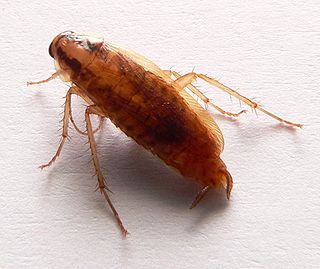
Giant cockroaches, or blaberids, are the second-largest cockroach family by number of species. Mostly distributed in warmer climates worldwide, this family is based on the American genus Blaberus, but much of the diversity is also found in Africa and Asia.

Ectobiidae is a family of the order Blattodea (cockroaches). This family contains many of the smaller common household pest cockroaches, among others. They are sometimes called wood cockroaches. A few notable species include:

The Tettigoniinae are a subfamily of bush crickets or katydids, which contains hundreds of species in about twelve tribes.

The Phaneropterinae, the sickle-bearing bush crickets or leaf katydids, are a subfamily of insects within the family Tettigoniidae. Nearly 2,060 species in 85 genera throughout the world are known. They are also known as false katydids or round-headed katydids.

Antaxius is a genus of bush crickets in the tribe Platycleidini found in Europe.

Blattellinae is a subfamily of the wood cockroach family, Ectobiidae. It includes the global household pest Blattella germanica, the German cockroach, and a number of endangered species. It contains about 70 genera.

Mogoplistidae is a family of scaly crickets within the superfamily Grylloidea. Considered to be monophyletic, a sister taxon to the Gryllidae crickets. This family consists of more than 370 species worldwide; 20 species in 4 genera occur in North America and this family includes the scaly crickets of Europe.

Neostylopyga is a genus of cockroaches described by Robert Walter Campbell Shelford in 1911.

The Pseudophyllodromiinae are a subfamily of cockroaches, in the family Ectobiidae, with a world-wide distribution.

Epilampra is a genus of cockroach in the family Blaberidae. There are more than 70 described species in the genus Epilampra.

Symploce is a genus of cockroach in the family Ectobiidae.

Trigonidium is a large genus of sword-tail crickets, typical of the tribe Trigonidiini. Records of occurrence are from Europe, Africa, tropical Asia, Australia and the Pacific islands; many species endemic to Pacific islands including Hawaii have now been placed in the genus Nudilla.

Clonaria is an Asian genus of stick insects belonging to the tribe Gratidiini.
Rhaphidophora is the type genus of camel crickets in the tribe Rhaphidophorini.

Rhabdoblatta is a genus of cockroaches in the subfamily Epilamprinae. Species have been recorded from Africa, East, Southeast and South Asia.

Balta is a genus of cockroaches in the sub family Pseudophyllodromiinae. Found in Asia, Africa, Australia and Oceania. The genus was created in 1893 by Johann Tepper.

Panesthia is a large genus of burrowing giant cockroach in the subfamily Panesthiinae. It is subsocial and its species are mainly found in Southeast Asia, coastal East Asia, Australasia, and Indo-Malaysia.

Amusurgus is a genus of Asian "sword-tail crickets", in the subfamily Trigonidiinae and the tribe Trigonidiini, erected by Carl Brunner von Wattenwyl in 1893. Species records exist for Pakistan through to Japan, South-East Asia through to Australia.

Loboptera is a genus of mostly Palaearctic cockroaches erected by Carl Brunner von Wattenwyl in 1865; it appears to be currently placed in the subfamily Blattellinae. The recorded distribution for species includes: mainland Europe, North Africa, Cameroun, the Middle East through to central Asia.
Dziriblatta is a genus of mostly Palaearctic cockroaches in the subfamily Ectobiinae, erected by Lucien Chopard in 1936. For several decades synonymized with Lobolampra, the genus was returned to valid status by Bohn in 2019, who provides information on its characteristics and differentiation from other genera, with a key to the subgenera. The species distribution includes: North Africa, the Iberian peninsula and associate Atlantic Ocean islands, with probably incomplete locality records to Cyprus and the Middle East.

















